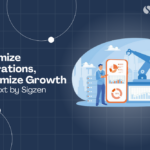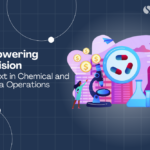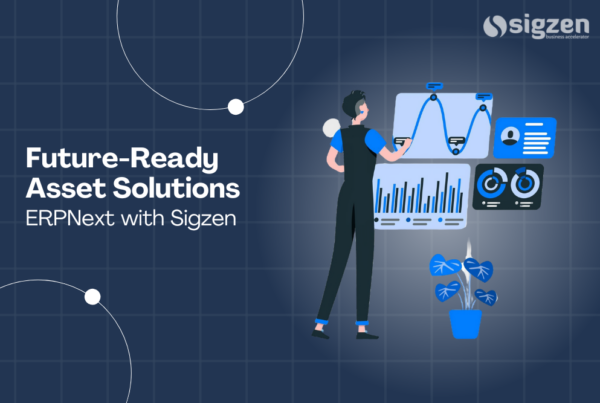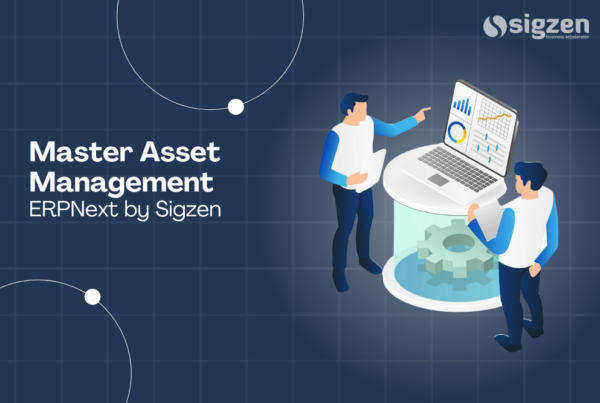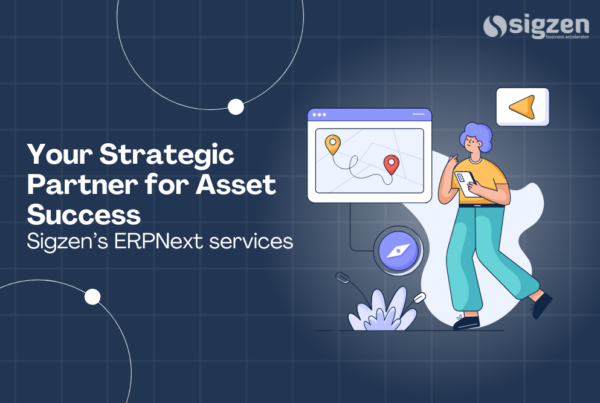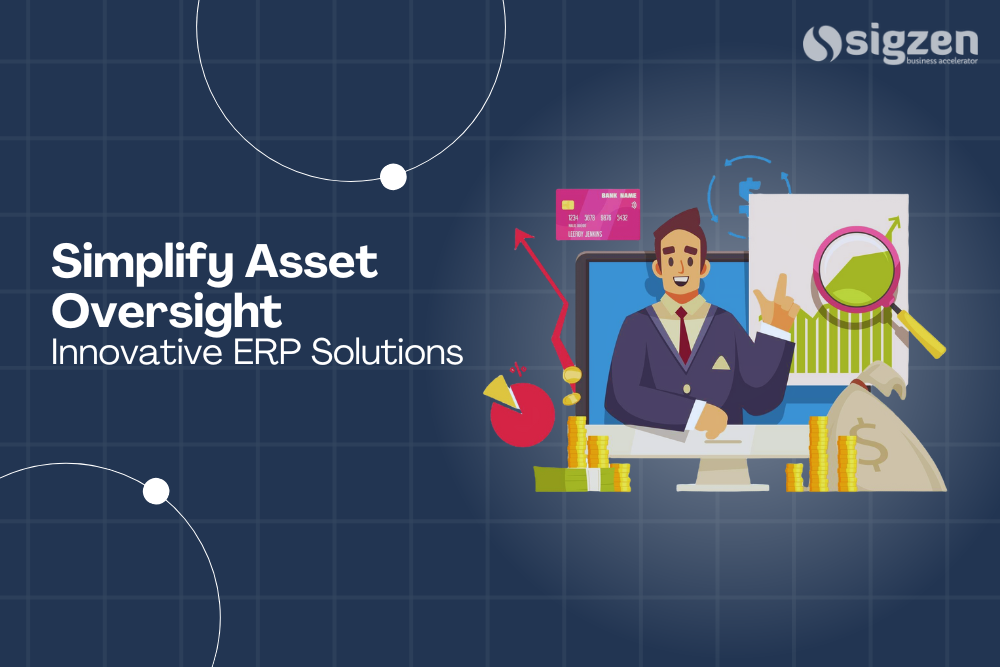
ERPNext Asset Management, a powerful solution designed to streamline asset tracking and optimization. With assets forming the backbone of businesses, managing them efficiently is crucial for sustained success. Developed by seasoned ERPNext professionals, ERPNext Asset Management offers a comprehensive framework for managing assets throughout their lifecycle, from acquisition to disposal.
In this guide, we’ll delve into its features and benefits, showcasing how businesses can leverage this tool to optimize asset utilization, reduce costs, and drive operational efficiency. Join us on this journey to master the art of asset management with ERPNext.
Sigzen Technologies has redefined ERPNext Asset Management by delivering tailored solutions that address businesses’ diverse needs. Through continuous R&D, Sigzen expands ERPNext’s features, introducing advanced tools for efficient asset tracking and management. Their focus on integration ensures seamless compatibility with other systems, streamlining workflows for enhanced productivity. As ERPNext experts, Sigzen’s commitment to innovation empowers businesses to optimize asset management processes, driving efficiency and success.
1. Comprehensive Asset Tracking
This feature enables you to monitor assets throughout their entire lifecycle, from procurement or creation to disposal, with ERPNext Asset Management Services By Sigzen Technologies. It helps you keep track of everything you own, ensuring nothing falls through the cracks.
- Accuracy: Maintain precise records of asset details throughout their lifecycle, including acquisition, usage, maintenance, and disposal. This ensures that you have a complete and accurate overview of all assets within your organization.
- Visibility: Gain real-time visibility into the status and location of assets across the organization. This transparency enables efficient asset management, reduces the risk of loss or misplacement, and enhances accountability.
- Efficiency: Streamline asset management processes by centralizing tracking and eliminating manual data entry errors. This improves operational efficiency, reduces administrative burden, and ensures that asset information is always up-to-date.
2. Customizable Asset Categories
This feature allows you to categorize assets based on your organization’s specific requirements, tailored to different types of assets, with ERPNext Asset Management Services By Sigzen Technologies. You can organize assets in a way that makes sense for your business, streamlining your asset management process.
- Flexibility: Tailor asset categories to match the specific needs and structures of your organization. This flexibility allows you to categorize assets based on various criteria such as department, location, or type, facilitating customized reporting and analysis.
- Organization: Organize assets systematically by categorizing them into custom-defined groups. This structured approach simplifies asset management by enabling you to quickly locate and retrieve relevant information when needed.
- Scalability: Scale the categorization system as your organization grows or changes. Whether you’re adding new assets, expanding operations, or restructuring departments, customizable categories ensure that your asset management system remains adaptable and responsive to evolving needs.
3. Depreciation Management
Depreciation management enables you to track the decrease in value of your assets over time, ensuring financial transparency and compliance with ERPNext Asset Management Services By Sigzen Technologies. It helps you understand how asset values change over time, aiding in budgeting and decision-making.
- Compliance: Ensure compliance with accounting standards by accurately calculating and recording asset depreciation over time. This helps you maintain accurate financial records and adhere to regulatory requirements.
- Decision Making: Use depreciation data to inform strategic decisions regarding asset maintenance, repairs, replacements, or upgrades. By understanding how assets depreciate over time, you can plan and budget effectively for future investments.
- Financial Transparency: Enhance financial transparency by tracking depreciation expenses and valuing assets accurately on balance sheets and financial statements. This provides stakeholders with a clear understanding of the organization’s asset value and financial health.
4. Maintenance Scheduling
Maintenance scheduling allows you to plan and schedule routine maintenance tasks for your assets, optimizing asset performance and extending their lifespan with ERPNext Asset Management Services By Sigzen Technologies. You can schedule maintenance to prevent breakdowns and minimize downtime.
- Preventive Maintenance: Schedule routine maintenance tasks proactively to prevent asset breakdowns and prolong their lifespan. This reduces the risk of unplanned downtime, improves asset reliability, and minimizes repair costs.
- Downtime Reduction: Minimize asset downtime by planning maintenance activities during non-critical periods. By scheduling maintenance strategically, you can minimize disruptions to operations and maintain productivity levels.
- Cost Savings: Reduce repair costs and extend asset longevity by implementing timely maintenance schedules based on usage patterns and manufacturer recommendations. This proactive approach to maintenance helps optimize asset performance while minimizing operational expenses.
5. Asset Location Tracking
Asset location tracking provides real-time visibility into the whereabouts of your assets within your organization, improving inventory management and optimizing asset utilization with ERPNext Asset Management Services By Sigzen Technologies. You can easily find where your assets are located, reducing search time and increasing operational efficiency.
- Visibility: Monitor the real-time location of assets within the organization. This visibility enables you to quickly locate and retrieve assets as needed, reducing search time and improving operational efficiency.
- Inventory Management: Improve inventory management by tracking asset movements across different locations or departments. This ensures that assets are properly accounted for and eliminates the risk of loss or theft.
- Security: Enhance asset security by preventing loss, theft, or misuse through continuous monitoring of asset locations and movements. By knowing the whereabouts of assets at all times, you can implement security measures to protect valuable resources.
6. Barcode and QR Code Integration
This feature integrates barcode and QR code technology into asset management, simplifying data entry and enhancing efficiency with ERPNext Asset Management Services By Sigzen Technologies. You can scan codes to quickly identify assets, speeding up inventory processes.
- Organization: Integrate barcode and QR code technology to streamline asset identification and tracking processes. This facilitates swift and accurate scanning, reducing manual data entry and the likelihood of errors.
- Accuracy: Enhance data accuracy by enabling automatic updates of asset information through code scanning. This not only ensures up-to-date records but also minimizes discrepancies.
- Accessibility: Enable convenient access to asset information via mobile devices equipped with barcode or QR code scanning capabilities. This enhances the accessibility of asset data, enabling authorized personnel to retrieve information on the go.
7. Asset History and Audit Trail
Asset history and audit trail functionality maintain a detailed record of all activities related to each asset, ensuring compliance and facilitating data-driven decisions with ERPNext Asset Management Services By Sigzen Technologies. It keeps track of everything that happens to each asset, providing a clear trail of accountability.
- Transparency: Maintain a comprehensive record of all asset-related activities, transactions, and modifications to uphold transparency and accountability standards.
- Compliance: Document asset histories and audit trails to facilitate compliance with regulatory requirements and internal policies. This aids in demonstrating adherence during audits, mitigating compliance risks.
- Troubleshooting: Utilize asset histories for troubleshooting, trend analysis, and process optimization. By leveraging historical data, you can identify patterns, assess performance, and make informed decisions to enhance asset management practices.
8. Integration with Procurement and Finance Modules
Integration with procurement and finance modules ensures data consistency and improves organizational efficiency with ERPNext Asset Management Services By Sigzen Technologies. It helps different parts of your business work together smoothly, streamlining operations.
- Data Consistency: Integrate asset management with procurement and finance modules to ensure consistency and accuracy of asset data across different business functions.
- Workflow Automation: Automate asset creation, updates, and financial transactions to reduce manual efforts and potential errors, thereby improving operational efficiency.
- Streamlined Processes: Seamlessly link asset management with purchasing, invoicing, and accounting processes to streamline procurement-to-payment workflows. This integration eliminates redundancies, enhances data accuracy, and expedites the procurement cycle.
9. Asset Performance Analytics
Asset performance analytics provide insights into key performance metrics, enabling informed decisions and cost savings with ERPNext Asset Management Services By Sigzen Technologies. You can see how well your assets are performing, identifying areas for improvement and optimization.
- Insight Generation: Generate actionable insights into asset performance metrics such as uptime, downtime, and maintenance costs to drive data-driven decision-making and optimize asset utilization.
- Optimization Opportunities: Identify opportunities for optimizing asset utilization, improving efficiency, and reducing operating costs based on performance analytics.
- Data-Driven Decisions: Utilize data-driven analytics and performance indicators to make informed decisions regarding maintenance schedules, asset investments, and resource allocation, thereby enhancing operational efficiency and reducing downtime.
10. Document Management
Document management functionality allows you to attach and store relevant documents to each asset record, facilitating compliance and troubleshooting with ERPNext Asset Management Services By Sigzen Technologies. You can easily access important documents related to your assets, ensuring all necessary information is readily available.
- Centralization: Centralized storage of relevant asset documents, including warranties, manuals, and service contracts, within the asset management system for easy access and association with corresponding assets.
- Accessibility: Ensure easy access to essential documentation for assets, facilitating compliance, troubleshooting, and decision-making processes.
- Data Integrity: Maintain data integrity and completeness by associating relevant documents with corresponding asset records, enhancing auditability, accountability, and compliance with regulatory requirements. This ensures that all necessary documentation is readily available for inspection.
11. Multi-location Support
Multi-location support enables you to manage assets across multiple physical locations from a centralized system, ensuring standardized processes and consistent asset tracking with ERPNext Asset Management Services By Sigzen Technologies. You can manage assets no matter where they are located, promoting efficiency and uniformity.
- Centralized Control: Manage assets across multiple locations or branches from a centralized system, providing visibility and control over dispersed asset inventories. This centralized approach ensures consistency in asset management practices and facilitates efficient resource allocation.
- Standardization: Standardize asset management processes and data across diverse locations, ensuring consistency and compliance with organizational policies. This promotes uniformity in asset tracking, reporting, and maintenance procedures, regardless of geographic location.
- Planning : Improve efficiency and collaboration by enabling seamless data sharing and communication between different locations or departments within the organization. This fosters collaboration, enhances decision-making, and optimizes resource utilization across the entire organization.
12. User Role-Based Access Control
User role-based access control protects data integrity and ensures compliance with security regulations with ERPNext Asset Management Services By Sigzen Technologies. It ensures that only authorized users can access sensitive asset information, safeguarding your data against unauthorized access.
- Security: Protect sensitive asset information and ensure data security by assigning role-based access control to users. This restricts access to authorized personnel only, reducing the risk of unauthorized access, data breaches, or misuse of sensitive information.
- Granularity: Define user roles and permissions based on job responsibilities, restricting access to specific functionalities or data based on user roles. This granular control ensures that users only have access to the information and features necessary for their respective roles, enhancing data security and confidentiality.
- Compliance: Maintain compliance with privacy regulations and internal security policies by controlling access to confidential asset data and functionalities based on user roles. This ensures that sensitive information is protected, and regulatory requirements are met, mitigating compliance risks and potential liabilities.
ERPNext Asset Management provides businesses with a robust platform to streamline asset tracking and management processes. Through features such as customizable categories, depreciation management, maintenance scheduling, and asset location tracking, businesses can effectively monitor assets from acquisition to disposal. This not only enhances accuracy and visibility but also improves efficiency by centralizing tracking and eliminating manual errors.
With ERPNext Asset Management, businesses can optimize asset utilization, reduce costs, and drive overall operational efficiency, ultimately contributing to sustained success.
